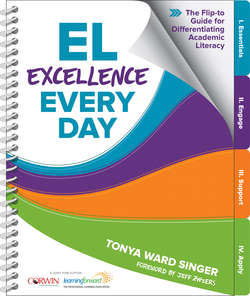Читать книгу EL Excellence Every Day - Tonya Ward Singer - Страница 40
На сайте Литреса книга снята с продажи.
5. Use Contrastive Analysis to Build on Primary Language Assets
ОглавлениеContrastive analysis is a strategy of engaging students in contrasting two ways of communicating the same message for the same purpose, one in the students’ home language or dialect and one in the new language (LeMoine & Soto, 2017; Taylor, 1991). In my Chinese example, I guide the student in contrasting the two grammatical structures for “How are you?” by writing the two different versions one above the other, in English, as follows:
You good not good.
How are you?
I point to the first example and acknowledge that this grammar is correct in Chinese. I explain that in English we don’t use the same structure. Instead, we use a different structure (I point to “How are you?”) to ask a question. Then I say, “Let’s read it together.”
This is one way to have an asset mindset about students’ linguistic strengths. We don’t just correct what is “wrong” in English; we are curious about what the student already knows and can do in another language that directly relates to this learning. We look to see what grammatical rules the student is applying from the first language, then help the student contrast the two languages side by side to learn the specific difference. Whereas pointing out errors negates students’ primary language knowledge, a contrastive analysis approach helps students engage in the high-level process of analyzing how different uses of language are appropriate for different contexts. This is an important concept both for English language arts and for effective bilingual communication.
To learn more about contrastive analysis including specific strategies and texts that especially benefit SELs with fluency in African American English, read pages 39–46 of Noma LeMoine and Ivannia Soto’s book Academic Language Mastery: Culture in Context (2017).
